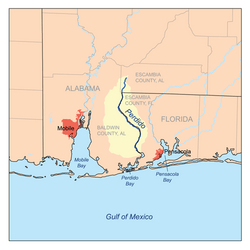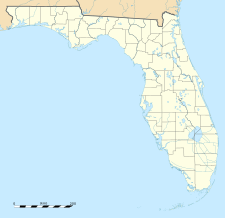Pensacola Pass facts for kids
|
Pensacola Pass is in the Florida Panhandle, right by the Gulf of Mexico.
|
Pensacola Pass is like a big watery doorway. It connects Pensacola Bay to the huge Gulf of Mexico. This important passage separates mainland Florida from Santa Rosa Island.
The area around Pensacola Pass is quite busy with many tall buildings. But there are also beautiful beach parks nearby. You can find Fort Pickens on the eastern side of the Pass.
Contents
What is Pensacola Pass?
Pensacola Pass is the name for the water channel that links the Gulf of Mexico to Pensacola Bay. It's a busy route for ships and boats. They use it to travel between the two bodies of water.
Every day, fresh saltwater from the Gulf flows into Pensacola Pass during the flood tide. This is when the water level rises. Then, during the ebb tide, the water flows back out. This helps to keep the bay clean. The Pass is located in Escambia and Santa Rosa counties in Florida. It's protected from big ocean waves by the Fairpoint peninsula and Santa Rosa Island. The Pass is about 21 kilometers (13 miles) long and 4 kilometers (2.5 miles) wide.
A Look Back: History of Pensacola Pass
The area around Pensacola Pass has a long and interesting history. Many different Native American tribes lived here. The Creek people, who spoke a Muskogee language, controlled much of the southern United States. The local Creek people were called the "Pensacola People." This is where the name for the area comes from. Today, the Santa Rosa County Creek Indian Tribe still works to share Native American cultures and traditions.
Early European Explorers
Europeans first explored the Pensacola area in the 1500s. Diego Miruelo was the first Spanish explorer to sail into Pensacola Bay. Later, Panfilo de Narvaez and Hernando de Soto also explored the bay. They called it the "Bay of Ochuse," after the Ochuse natives who lived there.
First Spanish Settlement
The first Spanish settlement in Pensacola was started in 1559. It was led by explorer Tristan de Luna y Arenallo. He named it "Bahia Santa Maria de Filipina." About 1,400 people arrived on 11 ships from Mexico. This was the first European settlement in what is now the United States.
However, a strong hurricane almost completely destroyed the colony. The people who survived left in 1561. It seemed like Florida might be too dangerous to settle. So, the area was left alone for 135 years.
Spanish Return to Pensacola
In 1693, a Spanish leader named Gaspar de Sandoval Silva, Count of Galve, sent a small team to explore the Gulf Coast. They wanted to see if the land was good for a new settlement. A famous scientist, Carlos de Singuenza, was with them. He renamed the bay "Santa Maria de Galve." He wrote that the land was a "paradise."
In 1698, a new Spanish settlement was built near Pensacola Pass. It was meant to protect against the French, who controlled nearby Louisiana. Andres de Arriola became governor. He found that conditions in Florida were much harder than Singuenza had described.
Changes in Control
The Spanish became allies with other groups against the English. But in 1719, the French took over Pensacola with their ships and Native American allies. The Spanish commander didn't even know a war had started. He had to surrender the fort.
Another hurricane hit in 1722. The French then left the city and burned it. This was to stop the Spanish from taking it back. The local Spanish built a new city. This time, they built it on the mainland instead of Santa Rosa Island. This helped protect it from big waves and bad weather.
Over the years, control of Pensacola changed hands several times:
- The Spanish (1722-1763)
- British West Florida (1763-1781)
- The Spanish (1781-1819)
The War of 1812 changed things near Pensacola Pass. Spain's power in America became weaker. The United States eventually took over the area. They built a navy yard and three forts around Pensacola.
The 2010 Gulf Oil Spill
In 2010, a huge oil spill happened in the Gulf of Mexico. It was called the Deepwater Horizon oil spill. Because of this, the entrance to Pensacola Pass was closed. A floating barrier system was put in place in June 2010. This was to stop oil from entering Pensacola Bay. The daily high tide was pushing oil-filled water into the bay.
The plan was for the barrier system to let boats through during the outgoing tide. But it would close during the rising tide. However, this plan didn't fully work. Strong currents in the Pass broke the barrier. There was no other system to trap the oil. So, oil freely entered Pensacola Pass.
After the Oil Spill
The beaches in Pensacola were hit very hard by the oil spill. Within two weeks, the oil had reached Pensacola Pass. The Gulf Oil Spill harmed local wildlife and damaged the natural environment. Fish that didn't die were unsafe to eat. This caused problems for seafood restaurants. The beaches turned black, and tourism suffered greatly.
Tourism was the main way people in the area made money. So, the economy was badly hurt. Many people called it a "lost summer." Research showed that major cities between Pensacola and Panama City lost about $150 million each month. This was during June, July, August, and September of 2010. This happened when unemployment was already high from a recession. Businesses reported losing 50% to 80% of their income that summer.
BP Oil, the company responsible for the spill, agreed to pay millions of dollars. These payments helped with environmental cleanup and economic growth. This helped the tourist industry bounce back strongly. Tourism income went from $5.4 million in 2010 to $12.3 million in 2019.
Long-Term Effects and Cleanup Efforts
Recent studies show that beaches affected by the oil spill might take over 30 years to fully recover. But local governments and volunteers are working hard to clean up Pensacola beaches. In 2019, 447 sites with oil were being managed. Twenty-eight of these sites were successfully cleaned up and closed.
People continue to protest against burning fossil fuels like oil. They also work to raise awareness about Climate Change. Days after the oil reached the shore, President Obama visited the Panama beaches. He promised a "huge federal response" to this major environmental disaster.
In response to the Deepwater Horizon incident, Escambia County passed the RESTORE Act. This county received 97% of the oil in Florida. The Act says that money from fines paid by those responsible for the spill will be used to protect the Gulf Coast's environment and economy. Other programs, not under the RESTORE Act, also received money from the oil spill fines.
Other Environmental Concerns in Pensacola
Pensacola has faced other environmental challenges. It recently ranked high in the United States for toxic releases per square mile. Pollution from factories, landfills, and septic tanks has made conditions difficult in the Pensacola area and Escambia County.
In 1999, pollution became so bad that a special group was formed. They looked into the local air and water quality. This group found that local regulators were not doing enough to reduce pollution. Some large companies found ways around rules. Others convinced local governments to make rules less strict. The group made 27 suggestions on how the county could protect its natural resources. Many people believe these suggestions are still not fully followed.
Pensacola has also had other major environmental problems. There was the Saufley Field Landfill fire. Waste with certain toxic levels was burned there. The fire created dangerous gases and particles. This fire burned for four months in 2005 and 2006. In 2017, there was an explosion at International Paper. This launched sticky black debris all over nearby neighborhoods.



